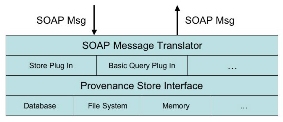PASOA
Start of topic | Skip to actions
PReServ 0.3.1
P-assertion Recording for Services
Provenance Query interface to the provenance store: functional specification of this interface can be found here.
XQuery interface to the provenance store: documentation on using this interface can be found here.
Motivation
The importance of understanding the process by which a result was generated in an experiment is fundamental to science. Without such information, other scientists cannot replicate, validate, or duplicate an experiment. For generations, scientists have used lab notebooks to record the process by which an experimental result was produced. These scientists were capturing provenance, which for some data is the documentation of process that led to that data. However, with large scale insilico experiments, it may difficult for a scientist to capture provenance especially when the experiment is conducted using thousands of computers owned and operated by different organisations. In order to facilitate the recording and querying of provenance, PASOA has developed PReServ an implementation of the Provenance Recording Protocol (PReP).Software Components
The following is a description of the software components that make up PReServ. The interaction between these components is shown in figure 1.

Figure 1: PReServ Component Interactions

Figure 2: PReServ Layers
Get PReServ
- Java Version 1.5
- Apache Tomcat 5 or greater
- Apache Ant 1.62
- If you need to run PReServ under Java 1.4 please contact us. We are moving towards adopting Java 1.5 completely on the Provenance Service side while maintaining Java 1.4 compatibility on the client side.
- Bug fixes and performance improvements
- Build file now contains targets to deploy/undeploy preserv from the command line
- Support for clients to server gzip compression
- The backend automatically compresses data
- We now use an in house xquery engine, LAXQuery, which provides greater scalability than the engine we used previously, IPSIXQ.
- Support for changing between LAXQuery and IPSIXQ in the web.xml configuration file
- Changes to the code to allow for easier development of multiple backends
- Code reorganisation to allow for a better set of distributions
- Fixed several threading bugs
- Compatible with the 025 Provenance Schemas
- This release is compatible with a version 024 Provenance Schemas. These schemas increase the extensibility of the schemas.
- This release of PReServ is compatible with the 0.4 Client Side Library produced by the EU Provenance project
- Minor bug fixes in querying and recording
- Maintenance release
- Fixed minor bugs with dataAccessors
- Supports Provenance Query Inteface
- WSDL now designed for extensibility
- Fixed bugs in DOMWriter handling
- Improved Developer Friendly WSDL
- WSDL is now JAX-RPC compatible
- Provenance Service handles JAX-RPC requests
- Improved client library documentation
- Added ClientLibExample
- Improved building of provenance store (no need to modify any configuration files)
- Changes in WSDL interfaces to be clearer and consise
- Compatible with new structure of process documentation
- XQuery interface
- WSDL interfaces
- New database backend (easier to redeploy)
- Refactored code for future development, easier to add backends
- AxisHandler now supports the transmission of multiple tracers (replacing sessions)
- PReServ now is distributed with Axis 1.2 rc 3
- The example and axishandler were updated to be compatible with this version of axi
- Fixed a concurrency issue in the file system backend store
- Fixed bugs in in-memory backend store
- Fixed a bug in the querying of actor (additional) provenance
- Fixed a bug in the recording of actor (additional) provenance
- Minor improvement to configuration process
- Better automatic service naming by axis handler
- Proper seperation of autodeploy and build ant scripts
to top
Edit | Attach image or document | Printable version | Raw text | More topic actions
Revisions: | r1.25 | > | r1.24 | > | r1.23 | Total page history | Backlinks
Revisions: | r1.25 | > | r1.24 | > | r1.23 | Total page history | Backlinks